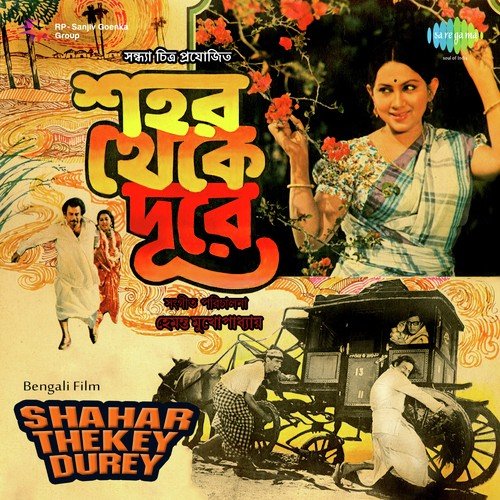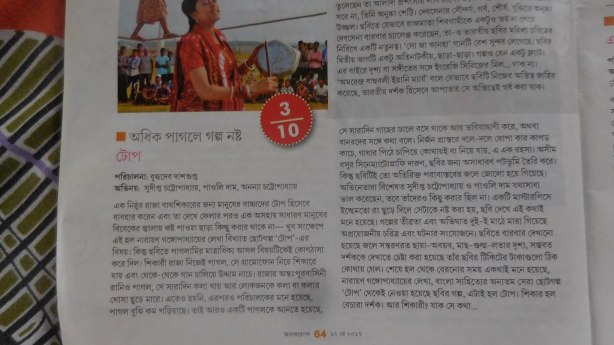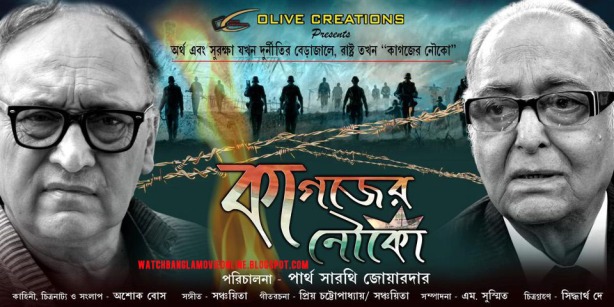
Ek Din Pratidin” (And Quiet Rolls the Day) remains an artistic triumph in the career of Mrinal Sen.
The gist: The narrative underlined what happens when a working girl doesn’t return home after work on a particular day. MS is one of the first to assess the changing position of women with industrialization and urbanization. Mamata Shankar, Gita Sen, Sreela Mazumdar & Satya Bandophyay comprised the cast.
Ek Din Pratidin was based on a story by famed Bengali writer Amalendu Chakravorty. A family of seven members with father (Satya Bandopadhyay), moher (Gita Sen), three sisters and two brothers are mostly dependent on the earning of a single member of the family, i.e. the eldest working daughter (Mamata Shankar).
The film opens with a long shot sequence of a hand-pulled rickshaw entering a claustrophobic neighborhood. Thereafter, it cuts to a young child getting hurt while playing, and taken to the clinic for treatment. One of the early sequence also shows a man urinating on the walls of the house where the family lived and the house-owner castigating the person concerned for the act – scenes of everyday life in Calcutta. MS always gave us such images from Calcuttan life in film after film.
The story unfolds slowly when the working girl doesn’t return home that night. At first, the family members kept silent hoping that she might have been working overtime, and will arrive late. The middle sister (Sreela Mazumdar in a superb performance) goes out to make a phone call to see if her sister might still be at the office. She returns home without being able to contact her.
Now the family members gets panicky, and the father goes out and watches the buses go by, without his daughter alighting from any of them. When the last bus also passes by, he returns home. Soon the inmates of the multiple storied building where both the landowner and his several tenants resided got wind of the fact that the working girl has not returned home that night.
The reactions from the various neighbors are depicted beautifully. Some makes acerbic comments, while others are more sympathetic. There are good Samaritan too who came to help the family in their hour of crisis. Two such characters, Shyamalda who stays in the same premise, and the scooter-owner friend of the brother goes out in search of the missing person. They head to the Police Station to lodge a complaint. Biplab Chaterji as a policeman, in a small role, excels. Biplab raids the family’s residence for basic inquiry, and extracts some facts about Mamata’s personal life (the type of garments she was wearing on that day). Sreela provided Biplab and his assisting officers with the necessary details.
Meanwhile, the brother and his friend check out the morgue to ascertain whether his sister’s dead body was brought there. The family also receives a news that a lady matching the description of the missing woman lay badly injured in an accident in Nilratan Medical Hospital. The father, along with the good neighbour Shyamalda, set off for the Hospital to find out…
It was found that the girl was not his daughter. They return home relieved.
However, it was a harrowing time for the family during the night. In the wee hours of the morning, the small girl of the family sights her eldest sister (Mamata Shankar) coming back. Surprisingly, everyone in the family eyed her with suspicion. No one asks her as to where she had been the previous night…
The landlord alights the staircase and asks the father to vacate the house as soon as possible. He harped upon the fact that the locality is meant only for decent people.
The last sequence shows Gita Sen in the morning hours(who was keeping bad health the previous night) begin her preparation for her everyday household chores…
The film was released in 1979, and won awards at several International Film Festivals. The camerawork by K K Mahajan is brilliant capturing effectively the moods and emotions of the actors & the tense atmosphere of the surroundings.
Analysis: The critics may find faults. They may argue that in a big city where neighbors live like virtual strangers, neighbors discussing the non-returning of the girl to the house at such length is not a realistic portrayal of modern times, where people are mostly unconcerned about the lives of others. Maybe such debatable issues apart, the novelty of the theme has never been explored in Indian cinema. Sen’s penchant to keep the audiences guessing as to where the girl disappeared is very much in evidence because he doesn’t offer any solution. Film Critic John W Hood finds an excellent example of the liberated woman in “Ek Din Pratidin”. “The heroine is her own boss. There is no answer to the question why she did not return home at night. Sen says it is her business where she had been.”
In an Interview, when Mrinal Sen was asked about his personal relationship with Satyajit Ray, Sen said that they never discussed each other’s films in great detail. Ray made some acerbic comment regarding this film, saying that the filmmaker doesn’t know where the women character had disappeared the previous night. Mrinal countered this and said that definitely he could have offered a solution in the film (the telephone call in the neighborhood medical dispensary late at night that went unanswered was an indicator of the missing woman trying to contact his family members) as to where the girl had disappeared, but that was not where the focus of the film lay. What he was trying to expose was the hollowness of our responses whenever misfortune befalls someone.
When the core theme remains the same, it is interesting to unravel how two great filmmakers approach it. The theme in question – exploitation of women and the filmmakers – Ritwik Ghatak (Meghe Dhaka Tara) & Mrinal Sen (Ek Din Pratidin). The film EK DIN PRATIDIN came roughly two decades after MEGHE DHAKA TARA. In the Ghatak work, we find novelty in sound design & lighting patterns, the use of classical music in the unfolding of the storyline. In terms of narrative style, it was quite straight-forward. The Mrinal Sen film is an experimentation to convey the message under the guise of a suspenseful incident. MS also incorporates several strands of calcuttan life deftly in his cinema. They become a living document of the lives of the citizens of his favorite city.
The interview: In the book ‘Out of God’s Oven: Travels in a fractured land’ by Dom Moreas and Sarayu Srivatsa (Penguin Viking, Pg 118) there is an interview of Mrinalda with the authors and a Japanese gentleman Watanabe. When asked to speak about his films, Mrinalda smiled ‘Of course, of course. About my films, let me see. Yes, recently I made a film about a middle class family. A woman, twenty five years old, she does not come home one night. She comes home the next morning. That is what the film is about.’
Watanabe looked amused. Mrinalda laughed. ‘When she doesn’t return her family members become worried. The neighbors ask question. They react. The film is about their reaction. Their reaction tells you about the middle-class-ness of Indian families. At the end of the film, the landlord asks the family to leave the flat; go elsewhere.’ Why? ‘Because everyone in the building say terrible things about the girl. If an Indian girl stays out of the house for a night, it is a very bad thing.’
Watanabe nodded slowly. ‘ Ah soo. Ah su desu ne. Rike Sita in Lamayana. I see now. Sita come home to God Lam , but she spend so many night out so Lam not accepting her. Hai, so desu ne, Lam was worried that Lavana would have touched Sita. So-so, the doubt was there in Lam’s mind. I see, I see. So, yo- a story based rittre bit on, Lamayana? Hai.’
Mrinalda digressed and said, “The film is about women, the inequalities that exist even now and how people treat women.’
Rating: 4.5 out of 5







